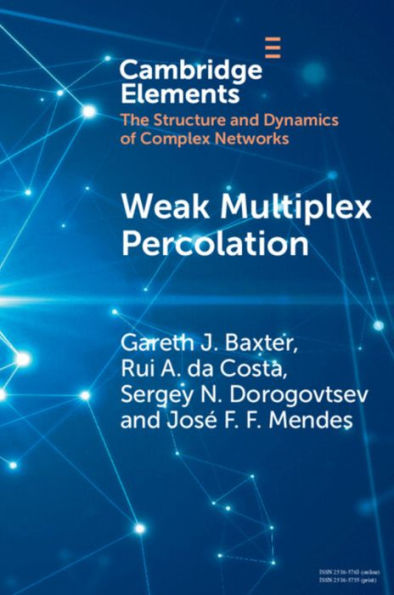Weak Multiplex Percolation
In many systems consisting of interacting subsystems, the complex interactions between elements can be represented using multilayer networks. However percolation, key to understanding connectivity and robustness, is not trivially generalised to multiple layers. This Element describes a generalisation of percolation to multilayer networks: weak multiplex percolation. A node belongs to a connected component if at least one of its neighbours in each layer is in this component. The authors fully describe the critical phenomena of this process. In two layers with finite second moments of the degree distributions the authors observe an unusual continuous transition with quadratic growth above the threshold. When the second moments diverge, the singularity is determined by the asymptotics of the degree distributions, creating a rich set of critical behaviours. In three or more layers the authors find a discontinuous hybrid transition which persists even in highly heterogeneous degree distributions, becoming continuous only when the powerlaw exponent reaches $1+1/(M-1)$ for $M$ layers.
1140170254
Weak Multiplex Percolation
In many systems consisting of interacting subsystems, the complex interactions between elements can be represented using multilayer networks. However percolation, key to understanding connectivity and robustness, is not trivially generalised to multiple layers. This Element describes a generalisation of percolation to multilayer networks: weak multiplex percolation. A node belongs to a connected component if at least one of its neighbours in each layer is in this component. The authors fully describe the critical phenomena of this process. In two layers with finite second moments of the degree distributions the authors observe an unusual continuous transition with quadratic growth above the threshold. When the second moments diverge, the singularity is determined by the asymptotics of the degree distributions, creating a rich set of critical behaviours. In three or more layers the authors find a discontinuous hybrid transition which persists even in highly heterogeneous degree distributions, becoming continuous only when the powerlaw exponent reaches $1+1/(M-1)$ for $M$ layers.
23.0
In Stock
5
1

Weak Multiplex Percolation
374
Weak Multiplex Percolation
374Paperback
$23.00
23.0
In Stock

Product Details
| ISBN-13: | 9781108791076 |
|---|---|
| Publisher: | Cambridge University Press |
| Publication date: | 01/27/2022 |
| Series: | Elements in the Structure and Dynamics of Complex Networks |
| Pages: | 374 |
| Product dimensions: | 5.94(w) x 8.98(h) x 0.16(d) |
From the B&N Reads Blog
